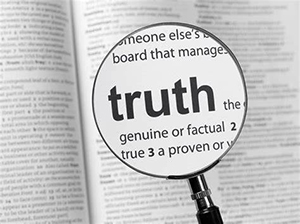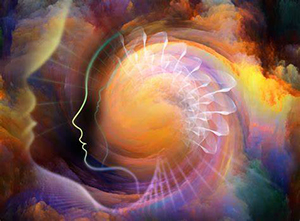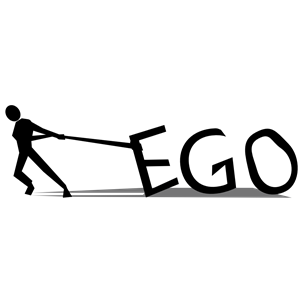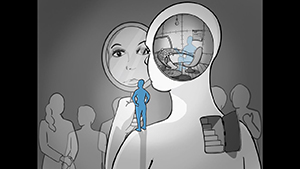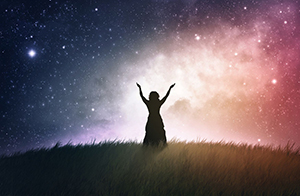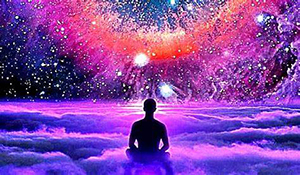Psychology
Individualisation in Integral Yoga Psychology
Abstract
This article is a broad overview of individualisation at the causal and instrumental level, from the perspective of Integral Yoga Psychology. What is the process of individualisation according to Integral Yoga Psychology? How does it differ from scientific and conventional psychological perspectives? What is the relationship between the evolving soul and the instrumental layers of the mental, vital, and physical nature? These are the topics explored in this article.
Three Perspectives on Psychology
The process of individualisation and its developmental stages would appear differently depending on the window through which you are looking at the process. From a yogic perspective, we can broadly divide all the approaches to psychology into three categories. They correspond to the gross body (sthūlaśarīra), the subtle body (sūkṣmaśarīra) and the causal body (kāraṇaśarīra). Each approach would posit the primary causation upon one of these bodies (see next page).
Yogic methods give a perspective seen from the causal body, kāraṇaśarīra, level and explain the subtle and gross body in terms of the causal body. It is not following the empirical and material approach of the scientific method nor does it follow psychoanalysis, phenomenology, linguistics or hypnosis. Its primary process of knowledge acquisition is through yogic knowledge, by identity or by knowledge, by intimate contact of consciousness with consciousness, and in both intuition, in a broad and general sense, plays a central role. There is a vast body of knowledge gathered by various yogic traditions. The view presented here is from the perspective of Integral Yoga Psychology, as developed by Sri Aurobindo and the Mother.
Who is the True Individual?
In the life-cycle of a human body on earth, there are two inheritances, from two sides of evolution, coming together. One inheritance is that of the evolving soul, the gains of past lives and the other is the inheritance from the material context of birth, the parental, hereditary and the social context.
| Outer / Objective | Inner / Subjective | Inmost / Pure Consciousness |
| Gross body (sthūlaśarīra) Materialism |
Subtle body (sūkṣmaśarīra) Psychology (Manasāstra) |
Causal body (kāraṇaśarīra) Spirituality (Ātamavidya) |
| Causation in terms of the gross body and its processes. | Causation in terms of deep contents and processes of the individual subjective states. | Causation in terms of pure consciousness - Soul and Spirit transcending the ego |
| Behaviourism Neurophysics Neurochemistry Biochemistry Psychiatric medicine Bioelectricity Cell Genome |
Psychoanalysis Phenomenology Philosophy Linguistics Hypnosis |
Yogic knowledge by identity Different types of samādhi Swapnasamādhi Nirvikalpasamādhi Karma samādhi Brahma samādhi |
| Third-person research | Second-person research | First-person research |
“... all human beings are made partly of what is given them by their ancestors (not only father and mother but all the ancestors), partly of what they bring with them. The part they get from the ancestors is called hereditary — it is part (not the whole) of the physical and lower vital consciousness, sometimes a little of the external mind also — it is a small portion of the external being, but although small, it is sometimes very persistent and active. The rest of the being, inner and a great part too of the external, is brought from past lives. This hereditary part has to be got rid of and replaced by the true individuality spreading itself to the whole external nature (1).”
The true person is the evolving soul going through a spiritual evolution towards individualisation. It is the immortal in the mortal, passing from one birth to another, carrying forward with it the gains from past lives. However, on the other end, the evolving soul uses three instrumental layers for its self-expression in the material world — the mental, vital and physical instrumentation. All these three instruments are also evolving and individualising, but it is only an ego formation, not the real individual. The ego is a surface formation at the level of the instrumental nature giving a sense of individual identity separate from the collective.
“In order to become a conscious, individualised being, one needs his ego; that is why it is there (2).”
For each layer of our instrumentation, there is a corresponding ego — mental ego, vital ego and physical ego. While the soul belongs to the causal domain, the mind belongs to the subtle, and the composite of the vital and physical belongs to the gross body.
“The formation of a mental and vital ego tied to the body-sense was the first great labour of the Cosmic Life in its progressive evolution; for this was the means it found for creating out of matter a conscious individual. The dissolution of this limiting ego is the one condition, the necessary means for this very same Life to arrive at its divine fruition: for only so can the conscious individual find either his transcendent self or his true Person (3).”
Physical Ego
When a child is born and the umbilical cord is cut, the physical body takes on autonomy and individuality, following a physical developmental process growing towards its physical adulthood and all the way towards ageing and death. It inherits the heredity from the parents and the generations that preceded it and yet each human body comes with a unique fingerprint! No two human bodies are exactly the same. Even at the material front end, there is a law of variation and individuality.
“In Matter variation is limited; there is variation of type, but, on the whole, uniformity of the individuals of the type. These individuals have a separate movement, but yet the same movement; subject to some minute differences, they adhere to one particular pattern and have the same assemblage of properties. Variety within the type, apart from minor unicities of detail, is gained by variation of group sub-types belonging to one general kind, species and sub-species of the same genus (4).”
We have racial types within the human species possessing unique physical features. There is further variation and subtypes all the way to the individual with a unique individuality of fingerprint and other patterns that are specific to an individual, however minor it is. Within the broad type of the species and its subtypes, there is a customisation of the individual body making it unique, a law of variation at work. Each individual body is a unique material construction, a unique form and ego construct that Nature has established in her evolutionary process. However, this ego and its processes are entirely beyond the cognitive range of the normal surface personality and its mental ego. Outwardly, this material mould is a product of biological evolution on earth and the Darwinian perspective on evolution essentially deals with the evolution of this mould.
Vital Ego
Subjectively, within our human mould, the vital movements are experienced as sensations seeking pleasure, instinctive reactions, impulses, drives like hunger and sex, desires, and greater impulsions to conquer and expand our territories, or to feel intimacy and deep connections with fellow beings and emotional bonding that builds families and clans. It operates through the duality of pleasure and pain, attractions and repulsions, and likes and dislikes. There is a pattern of behaviour, specific ways of responding to sensations, impulses, drives, desires and emotions. A predictable pattern of such behaviour is considered as the unique character or temperament of an individual or a community. The behaviour of this part of our being is quite close to that of animals, largely unconscious and habitual, following the herd.
Vital energy is universal and it animates all life on earth, bringing self-drive and purposeful locomotion with adaptive intelligent behaviour, governed by instinctive intelligence specific to a type or subtype but always with endless variation.
“The natural variation of human communities from each other proceeds on the same plan as the variation of individuals; each develops its own character, variant principle, natural law. This variation and fundamental following of its own separate law is necessary to its life, but it is equally necessary to the healthy total life of mankind (5).”
Nature operates on the foundation of unity and oneness but generates endless variety at every stage of her evolution.
“Her secret is clear enough from the fact that though she moulds on one general plan, she insists always on an infinite variation. [...] Human nature is one in its constituents and its grand lines, but no two human beings are precisely alike in their temperament, characteristics and psychological substance (6).”
Every social grouping has its particular vital temperament, characteristic and psychological substance and when you are born into a social context, unconsciously and habitually you inherit these formations. The vital ego is formed within this framework, providing a distinct sense of separation of one group from another and one individual from another within a group. Territoriality is a hallmark of this particular domain; the vital ego has a vaster extension than the boundary of the individual body and its physical ego.
Mental Ego
When you take birth in a specific social context, you are not only inheriting the heredity of the parental lineage and the vital temperaments of the social group, but you are also inheriting the mental formations of the society. All cultures and subcultures have their worldviews and narratives concerning the purpose of life and the notions of right and wrong, moral conventions, ethics and codes of conduct. Depending on the context of your birth and upbringing, you inherit corresponding mental belief-systems, experience them as your own and form your identity around them. First as the mental ego of the group and then within this formation, you own little variation providing a sense of unique individual identity. However, this is still only a habitual and surface formation of the mental ego, the surface personality, a mask.
The territorial sense of the vital ego usually gets extended to the mental ego and you would feel threatened when someone questions your belief-systems. You would feel your identity is getting attacked. The mental ego can further expand the sense of territoriality beyond the physical regional identities to a more subtle world of thoughts, ideas and belief-systems. It is still an ego nevertheless. Generally, developmental psychologists focus on the individualisation of the physical, vital and mental ego, the instrumental layers.
Evolution and Individualisation of the Soul
From an Integral Yoga Psychology perspective, the most important factor in becoming a true individual is the evolution and individualisation of the soul within.
“The soul is a spark of the Divine which is not seated above the manifested being, but comes down into the manifestation to support its evolution in the material world. It is at first an undifferentiated power of the divine consciousness, containing all possibilities, but at first with unevolved possibilities, which have not yet taken form, but to which it is the function of evolution to give form. This spark is there in all living beings, from the lowest to the highest (7).”
This spark, the immortal element in the mortal evolves through the process of rebirth in the material world, eventually developing into an individualised personality of the soul expressed through the human body and it is at this stage Integral Yoga calls it the psychic being.
“The psychic being is formed by the soul in its evolution. It supports the mind, vital, body, grows by their experiences, carries the nature from life to life. It is the psychic or caitya purussa. At first it is veiled by mind, vital and body, but, as it grows, it becomes capable of coming forward and dominating the mind, life and body (8);…”
This evolution and coming forward of the psychic being is the key to our evolutionary destiny on Earth.
Evolving From Animal to Man to God
“… it is a privilege to be born as a human being because the human body is the most sophisticated and evolved material frame in which the soul can individualise. Within an animal body, the possibility of individualisation is rare. Except for very rare cases, animals are not individualised and when they die, they return to the spirit of the species (9).”
The Mother explains the relationship between the spirit of the species and instinct.
“… what is called ‘instinct’ in animals is simply obedience to the spirit of the species which always knows what ought and ought not to be done (10).”
“The animal soul fulfils itself when it transcends animality and becomes human. Humanity also fulfils itself when it transcends humanity and becomes God (11).”
The individualisation of the soul becomes a possibility when it reaches the stage of evolution through the human body. This possibility opens the doors to evolve towards our divinity. Here we can see there are two sides to evolution simultaneously unfolding. One is at the causal level, the evolution of the soul, and the other is at the instrumental level, the evolution of the mental, vital and physical instrumentation, becoming increasingly capable of expressing the emerging divinity.
The human mind, the vital and physical instrumentation, are at the forefront of evolution on earth and it is within this instrumentation the individualisation of the soul is unfolding. The ability of an individual to override the instrumental ego formations is in direct proportion to the stage of evolution of the soul within. While many spiritual traditions focus on liberating the soul from the entrapment in the instrumental layers and eventual rejection of the instruments and earthly life, Integral Yoga looks at the possibility of accelerating the evolutionary transformation of the instrumental layers and divinising them by establishing higher stages of the soul’s evolution within the human mould.
References
1. Sri Aurobindo. The Complete Works of Sri Aurobindo, Volume 28. Pondicherry: Sri Aurobindo Ashram Trust; 2012, p. 521.
2. The Mother. The Collected Works of the Mother, Volume 6. Cent ed. Pondicherry: Sri Aurobindo Ashram Trust; 1979, p. 335.
3. Sri Aurobindo. Complete Works, Volume 23-24; 1999, p. 356.
4. Sri Aurobindo. Complete Works, Volume 25; 1997, p. 63.
5. Ibid., p. 424.
6. Ibid.
7. Sri Aurobindo. Complete Works, Volume 35; 2011, p. 148.
8. Ibid., pp. 148-49
9. The Mother. Collected Works, Volume 15; 1979, p. 127.
10. The Mother. Collected Works, Volume 4; 1979, p. 236.
11. Sri Aurobindo. Complete Works, Volume 12; 1997, p. 336
Manoj Pavithran, an Integral Yoga practitioner and educator, is co-founder of Purnam Centre for Integrality in Auroville, India.
Share with us (Comments,contributions,opinions)
When reproducing this feature, please credit NAMAH,and give the byline. Please send us cuttings.


